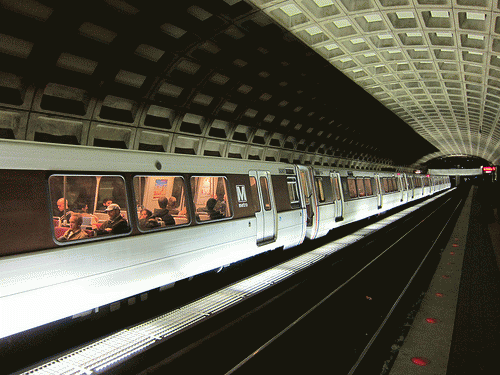
A DC Metro subway train arrives at a station carrying passengers
(Image by Andrew France) Details DMCA
Sixteen years ago the Japanese cult Aum Shinrikyo launched a chemical attack on the Tokyo subway system using crudely synthesized sarin nerve gas. The cult members believed that their attack would kick-start the apocalypse, and while they fell short in that goal they succeeded in killing 13 people and injuring hundreds of others. The Aum Shinrikyo, or Aum, subway attack is a well-known example of a chemical weapons attack, but many people may not realize that the cult had a history of launching largely unsuccessful chemical and biological weapons attacks. A new report by the Center for a New American Security, based on unprecedented access to convicted cult members, uses the Aum Shinrikyo incident as a case study of one group's attempts to produce and use chemical and biological weapons. The report reads like a compelling magazine story but comes with the analysis and citations expected of a leading think tank.
According to the report, Aum "used or tried to use, biological agents against six targets and chemical agents against 11 targets." However, the attacks were not terrorist attacks in the sense of being either motivated by political goals or intended to spread fear among a civilian population for political reasons or religious ideology. Instead, their attacks were for the most part either assassination attempts or intended to bring about the apocalypse. Accordingly, Aum was more akin to the Keystone Cops than Al-Qaeda. One cult member fell into and nearly drowned in a tank used to ferment botulism producing bacteria. A truck used to spray sarin in an attack caught fire severely poisoning the driver. During a separate attack "a slight breeze shifted the sarin plume" away from the intended target and towards a neighborhood killing eight people and injuring 200 others.
Despite these mistakes and their lack of success in producing effectively weaponized biological agents, Aum was quite successful in producing the chemical weapon sarin and using it in the subway attack. Even more frightening is the fact that even though the batch of sarin used in the subway attack was hurriedly produced with improvised ingredients and was less than pure the result was still deadly. The report questions how much worse the attack would have been if the cult had used the purer sarin they had produced earlier.
The Aum Shinrikyo subway attack is particularly instructive given that
subway systems in cities around the world have been targets for terrorists'
bombings since the attacks of September 11. The Associated Press reports
that these attacks have resulted in over 250 people killed and over two
thousand more wounded. Since 9-11
subway security in New York City has been heightened, and new security measures
have been put into place. These
include bomb-sniffing dogs, security cameras and high tech detection devices
for explosives components. Despite
these improvements, subway systems, which are used by millions of people in the
US each day, cannot be made entirely safe. "It's really a potentially very vulnerable environment
-- one that you can't totally protect," a security firm executive and former
police department head and chief of the New York City transit police told the
Associated Press. Moreover, since
the Aum attack, "The threat space has evolved," in the words of one of the
report's authors--meaning the technology and raw materials for weapons may be
more readily available, and new threats have emerged.
The threat to our nation's rail system is not merely hypothetical. According to the Los Angeles Times, "Evidence collected from Osama bin Laden's compound in Pakistan indicates that Al Qaeda considered launching a terrorist strike against America's rail system." So what is Congress doing to ensure the safety of our subways? Not enough says William Millar, President of American Public Transportation Association. He writes that in April of this year "Congress reduced transit security for [fiscal year] 2011 by $50 million from $300 million to $250 million as part of the budget deal." Mr. Millar believes that this is not enough since the 9-11 Commission Act called for more than double that amount for each year since fiscal year 2008.
At any given moment, dozens of the escalators in the Washington, DC Metro subway system are out of order. The problem is so chronic that an independent assessment of the escalator problem was performed last year. As a result, "The transit authority plans to spend more than $150 million during the next five to six years to rehabilitate and replace escalators and elevators," according to the Washington Post. Evidently it takes a crisis, an independent assessment and a six-year plan to fix the escalators in the subway system of our nation's capital. How much confidence should we have 16 years since the sarin gas subway attack that United States rail systems are safe?




